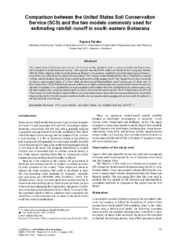Comparison between the United States Soil Conservation Service (SCS) and the two models commonly used for estimating rainfall-runoff in south-eastern Botswana
Abstract
The United States Soil Conservation Service (SCS) curve number method is used to estimate rainfall runoff from three sub-watersheds in South-Eastern Botswana. This approach uses the NASA Endeavour Shuttle Radar Topography Mission (SRTM) DEMs, digital soil data from the Botswana Ministry of Agriculture, rainfall data from the Department of Meteorological
Services and land-use data derived from Landsat ETM+ imagery. Runoff predicted from the SCS method is compared with the runoff calculated using the Pitman and Monash models and the gauged runoff. The Thagale River system watershed produces a mean annual volume of 7.2 Mm3 while the Notwane and Metsimotlhabe runoff volumes are 19.9 Mm3 and 17.8 Mm3 respectively. The SCS Model is found to be either over- or under-estimating the mean annual runoff volumes found using the other two models. It is concluded that more mean annual runoff volumes should be established for the whole country using the three models and a correlation analysis made in order to determine the superior model. The SCS Model uses a lot of Earth Observation (EO) and other data found in different government departments, hence this encourages collaboration. It is further observed that the SCS Model is quick to produce results, does not require stream gauging and can also easily be updated as the land use/land cover changes.
Collections
- Reseach articles [146]

